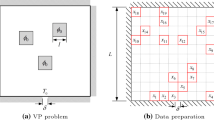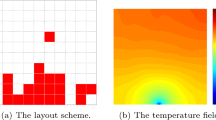Abstract
In practical engineering, the layout optimization technique driven by the thermal performance is faced with a severe computational burden when directly integrating the numerical analysis tool of temperature simulation into the optimization loop. To alleviate this difficulty, this paper presents a novel deep learning surrogate-assisted heat source layout optimization method. First, two sampling strategies, namely the random sampling strategy and the evolving sampling strategy, are proposed to produce diversified training data. Then, regarding mapping between the layout and the corresponding temperature field as an image-to-image regression task, the feature pyramid network (FPN), a kind of deep neural network, is trained to learn the inherent laws, which plays as a surrogate model to evaluate the thermal performance of the domain with respect to different input layouts accurately and efficiently. Finally, the neighborhood search-based layout optimization (NSLO) algorithm is proposed and combined with the FPN surrogate to solve discrete heat source layout optimization problems. A typical two-dimensional heat conduction optimization problem is investigated to demonstrate the feasibility and effectiveness of the proposed deep learning surrogate-assisted layout optimization framework.














Similar content being viewed by others
Notes
Accurately speaking, if taking the left-bottom vertex of the square layout domain as the origin and building the Cartesian coordinate system, the coordinates of this point are (0.1, 0.0561)m.
References
Abueidda DW, Almasri M, Ammourah R, Ravaioli U, Jasiuk IM, Sobh NA (2019) Prediction and optimization of mechanical properties of composites using convolutional neural networks. Compos Struct 111264:227. https://doi.org/10.1016/j.compstruct.2019.111264
Ahuja RK, Ergun Ö, Orlin JB, Punnen AP (2002) A survey of very large-scale neighborhood search techniques. Disc Appl Mathe 123(1-3):75–102. https://doi.org/10.1016/S0166-218X(01)00338-9
Aslan Y, Puskely J, Yarovoy A (2018) Heat source layout optimization for two-dimensional heat conduction using iterative reweighted L1-norm convex minimization. Int J Heat Mass Trans 122:432–441. https://doi.org/10.1016/j.ijheatmasstransfer.2018.02.001
Chen K, Wang S, Song M (2016a) Optimization of heat source distribution for two-dimensional heat conduction using bionic method. Int J Heat Mass Transfer 93:108–117. https://doi.org/10.1016/j.ijheatmasstransfer.2015.09.041
Chen K, Wang S, Song M (2016b) Temperature-gradient-aware bionic optimization method for heat source distribution in heat conduction. Int J Heat Mass Transfer 100:737–746. https://doi.org/10.1016/j.ijheatmasstransfer.2016.05.011
Chen K, Xing J, Wang S, Song M (2017) Heat source layout optimization in two-dimensional heat conduction using simulated annealing method. Int J Heat Mass Transfer 108:210–219. https://doi.org/10.1016/j.ijheatmasstransfer.2016.12.007
Chen X, Yao W, Zhao Y, Chen X, Zheng X (2018) A practical satellite layout optimization design approach based on enhanced finite-circle method. Struct Multidiscip Optim 58(6):2635–2653. https://doi.org/10.1007/s00158-018-2042-z
Chen X, Liu S, Sheng T, Zhao Y, Yao W (2019) The satellite layout optimization design approach for minimizing the residual magnetic flux density of micro- and nano-satellites. Acta Astronautica 163:299–306. https://doi.org/10.1016/j.actaastro.2018.12.006
Clark DL, Bae HR, Gobal K, Penmetsa R (2016) Engineering design exploration using locally optimized covariance kriging. AIAA J 54(10):3160–3175. https://doi.org/10.2514/1.J054860
Clarke SM, Griebsch JH, Simpson TW (2005) Analysis of support vector regression for approximation of complex engineering analyses. J Mechan Design 127 (6):1077–1087. https://doi.org/10.1115/1.1897403
Cuco APC, De Sousa FL, Silva Neto AJ (2015) A multi-objective methodology for spacecraft equipment layouts. Opt Eng 16(1):165–181. https://doi.org/10.1007/s11081-014-9252-z
Dong W, Liu J, Xie Z, Li D (2019) Adaptive neural network-based approximation to accelerate eulerian fluid simulation. In: Proceedings of the international conference for high performance computing, networking, storage and analysis, ACM, New York, USA, pp 1–22, DOI https://doi.org/10.1145/3295500.3356147, (to appear in print)
Fakoor M, Mohammad Zadeh P, Momeni Eskandari H (2017) Developing an optimal layout design of a satellite system by considering natural frequency and attitude control constraints. Aerosp Sci Technol 71:172–188. https://doi.org/10.1016/j.ast.2017.09.012
Fernández-Godino MG, Panda N, O’Malley D, Larkin K, Hunter A, Haftka RT, Srinivasan G (2020) Accelerating continuum-scale brittle fracture simulations with machine learning, arXiv:2001.11328
Forrester AI, Keane AJ (2009) Recent advances in surrogate-based optimization. Prog Aerosp Sci 45(1-3):50–79. https://doi.org/10.1016/j.paerosci.2008.11.001
Frankel AL, Jones RE, Alleman C, Templeton JA (2019) Predicting the mechanical response of oligocrystals with deep learning. Comput Mater Sci 169(July):109099. https://doi.org/10.1016/j.commatsci.2019.109099
Ghavamian F, Simone A (2019) Accelerating multiscale finite element simulations of history-dependent materials using a recurrent neural network. Comput Methods Appl Mech Eng 112594:357. https://doi.org/10.1016/j.cma.2019.112594
Goel T, Hafkta RT, Shyy W (2009) Comparing error estimation measures for polynomial and kriging approximation of noise-free functions. Struct Multidiscip Optim 38(5):429–442. https://doi.org/10.1007/s00158-008-0290-z
Golkarnarenji G, Naebe M, Badii K, Milani AS, Jazar RN, Khayyam H (2019) A machine learning case study with limited data for prediction of carbon fiber mechanical properties. Comput Ind 105:123–132. https://doi.org/10.1016/j.compind.2018.11.004
Han Z, Rahul, De S (2019) A deep learning-based hybrid approach for the solution of multiphysics problems in electrosurgery. Comput Methods Appl Mechan Eng 357:112603. https://doi.org/10.1016/j.cma.2019.112603
He K, Zhang X, Ren S, Sun J (2016a) Deep residual learning for image recognition. In: 2016 IEEE conference on computer vision and pattern recognition (CVPR), pp 770–778, https://doi.org/10.1109/CVPR.2016.90
He K, Zhang X, Ren S, Sun J (2016b) Identity mappings in deep residual networks. In: Computer Vision – ECCV 2016, Springer International Publishing, Cham, pp 630–645, https://doi.org/10.1007/978-3-319-46493-0_38
Hengeveld DW, Braun JE, Groll EA, Williams AD (2011) Optimal placement of electronic components to minimize heat flux nonuniformities. J Spacecr Rocket 48(4):556–563. https://doi.org/10.2514/1.47507
Hornik K, Stinchcombe M, White H (1989) Multilayer feedforward networks are universal approximators. Neural Netw 2(5):359–366. https://doi.org/10.1016/0893-6080(89)90020-8
Kingma DP, Ba J (2015) Adam: a method for stochastic optimization. In: 3rd international conference on learning representations, ICLR 2015, arXiv:1412.6980
Kissas G, Yang Y, Hwuang E, Witschey WR, Detre JA, Perdikaris P (2020) Machine learning in cardiovascular flows modeling: predicting arterial blood pressure from non-invasive 4D flow MRI data using physics-informed neural networks. Computer Methods in Applied Mechanics and Engineering 358:112623. https://doi.org/10.1016/j.cma.2019.112623
Krizhevsky A, Sutskever I, Hinton GE (2017) Imagenet classification with deep convolutional neural networks. Commun ACM 60(6):84–90. https://doi.org/10.1145/3065386
Lagaros ND, Charmpis DC, Papadrakakis M (2005) An adaptive neural network strategy for improving the computational performance of evolutionary structural optimization. Comput Methods Appl Mech Eng 194(30-33 SPEC. ISS.):3374–3393. https://doi.org/10.1016/j.cma.2004.12.023
Lecun Y, Bottou L, Bengio Y, Haffner P (1998) Gradient-based learning applied to document recognition. Proc IEEE 86(11): 2278–2324. https://doi.org/10.1109/5.726791
LeCun Y, Bengio Y, Hinton G (2015) Deep learning. Nature 521(7553):436–444. https://doi.org/10.1038/nature14539
Li X, Liu Z, Cui S, Luo C, Li C, Zhuang Z (2019) Predicting the effective mechanical property of heterogeneous materials by image based modeling and deep learning. Comput Methods Appl Mechan Eng 347:735–753. https://doi.org/10.1016/j.cma.2019.01.005
Liang L, Liu M, Martin C, Sun W (2018) A deep learning approach to estimate stress distribution: a fast and accurate surrogate of finite-element analysis. J Royal Soc Interface 15(138):20170844. https://doi.org/10.1098/rsif.2017.0844
Lin TY, Maire M, Belongie S, Hays J, Perona P, Ramanan D, Dollár P, Zitnick CL (2014) Microsoft COCO: common objects in context. In: ECCV, pp 740–755 https://doi.org/10.1007/978-3-319-10602-1_48
Lin TY, Dollar P, Girshick R, He K, Hariharan B, Belongie S (2017) Feature pyramid networks for object detection. In: 2017 IEEE conference on computer vision and pattern recognition (CVPR), vol 2017-January, pp 936–944, https://doi.org/10.1109/CVPR.2017.106
Liu M, Liang L, Sun W (2019) Estimation of in vivo constitutive parameters of the aortic wall using a machine learning approach. Comput Methods Appl Mech Eng 347:201–217. https://doi.org/10.1016/j.cma.2018.12.030
Meister F, Passerini T, Mihalef V, Tuysuzoglu A, Maier A, Mansi T (2020) Deep learning acceleration of total Lagrangian explicit dynamics for soft tissue mechanics. Comput Methods Appl Mech Eng 112628:358. https://doi.org/10.1016/j.cma.2019.112628
Nguyen TN, Lee S, Nguyen-Xuan H, Lee J (2019) A novel analysis-prediction approach for geometrically nonlinear problems using group method of data handling. Comput Methods Appl Mech Eng 354:506–526. https://doi.org/10.1016/j.cma.2019.05.052
Papadopoulos V, Soimiris G, Giovanis DG, Papadrakakis M (2018) A neural network-based surrogate model for carbon nanotubes with geometric nonlinearities. ComputMethods Appl Mechan Eng 328:411–430. https://doi.org/10.1016/j.cma.2017.09.010
Qin Z, Liang YG (2018) Multiobjective methodology for satellite cabin layout optimization considering space debris impact risk. J Spacecraft Rockets 55(1):232–235. https://doi.org/10.2514/1.A33908
Reimer AS, Cheviakov AF (2013) A MATLAB-based finite-difference solver for the Poisson problem with mixed Dirichlet-Neumann boundary conditions. Comput Phys Commun 184(3):783–798. https://doi.org/10.1016/j.cpc.2012.09.031
Russakovsky O, Deng J, Su H, Krause J, Satheesh S, Ma S, Huang Z, Karpathy A, Khosla A, Bernstein M, Berg AC, Fei-Fei L (2015) Imagenet large scale visual recognition challenge. Int J Comput Vis 115(3):211–252. https://doi.org/10.1007/s11263-015-0816-y
Shan S, Wang GG (2010) Survey of modeling and optimization strategies to solve high-dimensional design problems with computationally-expensive black-box functions. Struct Multidiscip Optim 41(2):219–241. https://doi.org/10.1007/s00158-009-0420-2
Simonyan K, Zisserman A (2015) Very deep convolutional networks for large-scale image recognition. In: 3rd international conference on learning representations, ICLR 2015, arXiv:1409.1556
Sun Z, Zhang Y, Yang G (2017) Surrogate based optimization of aerodynamic noise for streamlined shape of high speed trains. Appl Sci 7(2):196. https://doi.org/10.3390/app7020196
Szegedy C, Liu W, Jia Y, Sermanet P, Reed SE, Anguelov D, Erhan D, Vanhoucke V, Rabinovich A (2015) Going deeper with convolutions. In: 2015 IEEE conference on computer vision and pattern recognition (CVPR), DOI https://doi.org/10.1109/CVPR.2015.7298594, (to appear in print)
Tan RK, Zhang NL, Ye W (2019), A deep learning–based method for the design of microstructural materials. Struct Multidiscip Optim. https://doi.org/10.1007/s00158-019-02424-2
Teichert GH, Natarajan AR, Van der Ven A, Garikipati K (2019) Machine learning materials physics: integrable deep neural networks enable scale bridging by learning free energy functions. Comput Methods Appl Mechan Eng 353:201–216. https://doi.org/10.1016/j.cma.2019.05.019
Tompson J, Schlachter K, Sprechmann P, Perlin K (2017) Accelerating Eulerian fluid simulation with convolutional networks. In: 34th international conference on machine learning, ICML 2017, vol 70, pp 3424–3433, arXiv:1607.03597
Voulodimos A, Doulamis N, Doulamis A, Protopapadakis E (2018) Deep learning for computer vision: a brief review. https://doi.org/10.1155/2018/7068349
White DA, Arrighi WJ, Kudo J, Watts SE (2019) Multiscale topology optimization using neural network surrogate models. Comput Methods Appl Mech Eng 346:1118–1135. https://doi.org/10.1016/j.cma.2018.09.007
Xie HY, Yang Q, Hu XM, Chen WN (2017) Cross-generation Elites Guided Particle Swarm Optimization for large scale optimization. 2016 IEEE symposium series on computational intelligence, SSCI, 2016, DOI https://doi.org/10.1109/SSCI.2016.7850278, (to appear in print)
Yao W, Chen X, Ouyang Q, van Tooren M (2012a) A surrogate based multistage-multilevel optimization procedure for multidisciplinary design optimization. Struct Multidiscip Optim 45 (4):559–574. https://doi.org/10.1007/s00158-011-0714-z
Yao W, Chen X, Zhao Y, Van Tooren M (2012b) Concurrent subspace width optimization method for RBF neural network modeling. IEEE Trans Neur Netw Learn Syst 23(2):247–259. https://doi.org/10.1109/TNNLS.2011.2178560
Young T, Hazarika D, Poria S, Cambria E (2018) Recent trends in deep learning based natural language processing [Review Article]. https://doi.org/10.1109/MCI.2018.2840738
Zagoruyko S, Komodakis N (2016) Wide residual networks. In: 2017 IEEE conference on computer vision and pattern recognition (CVPR) pp 636–644 https://doi.org/10.5244/C.30.87
Zhang B, Teng HF, Shi YJ (2008) Layout optimization of satellite module using soft computing techniques. Appl Soft Comput 8(1):507–521. https://doi.org/10.1016/j.asoc.2007.03.004
Zhang Y, Yao W, Chen X, Ye S (2019a) A penalized blind likelihood Kriging method for surrogate modeling. Struct Multidiscip Optim. https://doi.org/10.1007/s00158-019-02368-7
Zhang Y, Yao W, Ye S, Chen X (2019b) A regularization method for constructing trend function in Kriging model. Struct Multidiscip Optim 59(4):1221–1239. https://doi.org/10.1007/s00158-018-2127-8
Zhang Z, Hong Y, Hou B, Zhang Z, Negahban M, Zhang J (2019c) Accelerated discoveries of mechanical properties of graphene using machine learning and high-throughput computation. Carbon 148:115–123. https://doi.org/10.1016/j.carbon.2019.03.046
Zhu Y, Zabaras N (2018) Bayesian deep convolutional encoder–decoder networks for surrogate modeling and uncertainty quantification. J Comput Phys 366:415–447. https://doi.org/10.1016/j.jcp.2018.04.018
Zhu Y, Zabaras N, Koutsourelakis PS, Perdikaris P (2019) Physics-constrained deep learning for high-dimensional surrogate modeling and uncertainty quantification without labeled data. J Comput Phys 394:56–81. https://doi.org/10.1016/j.jcp.2019.05.024
Funding
This work was supported in part by the National Natural Science Foundation of China under Grant Nos. 51675525 and 11725211.
Author information
Authors and Affiliations
Corresponding author
Ethics declarations
Conflict of interest
The authors declare that they have no conflict of interest.
Additional information
Responsible Editor: Nestor V Queipo
Replication of results
The code can be downloaded at https://github.com/idrl-lab/HSLO-DLSM.
Publisher’s note
Springer Nature remains neutral with regard to jurisdictional claims in published maps and institutional affiliations.
Rights and permissions
About this article
Cite this article
Chen, X., Chen, X., Zhou, W. et al. The heat source layout optimization using deep learning surrogate modeling. Struct Multidisc Optim 62, 3127–3148 (2020). https://doi.org/10.1007/s00158-020-02659-4
Received:
Revised:
Accepted:
Published:
Issue Date:
DOI: https://doi.org/10.1007/s00158-020-02659-4




